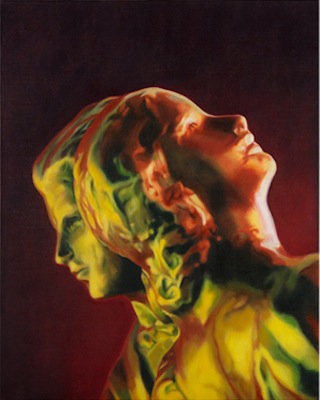For the exhibition Blow Up, now on view at Joyce Yahouda Gallery, Italian-Canadian painter Fabrizio Perozzi has created a beautiful group of paintings of a single object, a bronze statuette of a man and woman in a kind of embrace. As befits the theme, the conceptual parallels between Antonioni’s 1966 film,1 from which the exhibition takes its title, and Perozzi’s paintings become more complex the deeper we look.
At the time when Antonioni’s film made its debut, Bosley Crowther, film critic of The New York Times, made a statement that also resonates with these paintings and our contemporary experience: “it is a fascinating picture, which has something real to say about the matter of personal involvement and emotional commitment in a jazzed-up, media-hooked-in world so cluttered with synthetic stimulations that natural feelings are overwhelmed”.2
In this case, the artist’s personal involvement is related to the relationships, exchanges and material transformations over time and space of this object and its image. In the first, the writer Yves Navarre, who had the bronze cast done from an original plaster entitled Débuts, created by the Canadian sculptress E. de Montigny-Giguère (1878-1969), gave it to Perozzi in the 1990s as a gift. In the present, having already owned the statuette for well over a decade, we can easily imagine the painter becoming ever more imbricated with the object and their image with each new ‘zoom,’ angle, and focus of each representation in paint. Moreover, and closing this circle of relations, we could imagine the sense of increased proximity Perozzi might feel between himself and the long-dead artist who created the object decades earlier.
As the title indicates, cinema also has a part to play. Moreover, the black-and-white paintings in the room off the main gallery space are presented as film stills, deriving from the artist’s interest in the composition and character of photographic and cinematic images. This made me wonder what it means to treat the representation of a static and silent object as a “still,” as though its original state was in movement and sound; nevertheless the temptation to ascribe a narrative persisted, which I found myself doing in a few cases. In one of the large paintings in the main gallery space, the bright copper colours seemed to be caused by a great fire outside the frame, reflected on the molded surfaces of the figures. In another work, the acid greens and chartreuse yellows suggested some kind of radioactive explosion, from which the male figure appeared to be shielding the woman. This is almost certainly taking the “blow up” theme a bit too literally, but it does at least corroborate the theme of foreboding, of violence and the traces thereof within or just outside the frame.
While several artistic media are invoked in this exhibition–sculpture, photography, cinema, and painting–in the end it seems that the strongest connection it bears with the Blow Up of nearly fifty years ago is that they are both about the act of looking, across and through time and media. Perozzi’s highly accomplished and sensitive work is a product of intense and sustained looking, and a means for us to do the same.
Blow Up will be silently revealing itself until January 12, 2013.
Galerie Joyce Yahouda, space 516
Fabrizio Perozzi
Blow Up
November 15 – January 12, 2012
www.joyceyahoudagallery.com
1Blow Up is a 1966 film by Antonioni in which a photographer believes he has unwittingly captured a murder taking place on film. As he looks closer into the image he is also drawn into the complex story of the man, woman and murder.
2 Quoted from the Wikipedia page dedicated to Antonioni’s film. http://www.en.wikipedia.org/wiki/Blowup.



